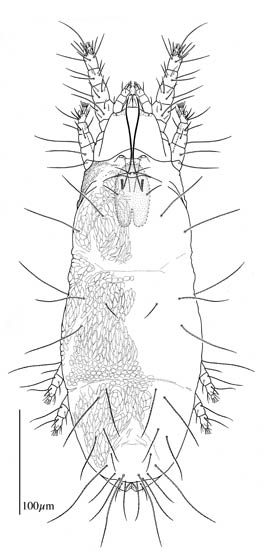Tetranychoidea: Linotetranidae
Superorder Acariformes
Order Trombidiformes
Suborder Prostigmata
Supercohort Eleutherengonides
Cohort Raphignathina
Superfamily Tetranychoidea
Family Linotetranidae
Common names: cryptic false spider mites
Probability of Encounter: Low
Quarantine importance:
Low. The Linotetranidae are associated with soil and grasses around the
world. None are known to be important plant pests.
Diagnosis:
-
Empodium with tenent hairs.
-
Prodorsum with 4 pairs of setae (vi, ve, sci, sce)
-
Adult female with 3 pairs of anal setae (males with 5 pairs of ano-genital setae).
-
Cheliceral bases adnate, fused mesally into a stylophore (sometimes withdrawn into the body); chelicerae with fixed digit reduced and movable digit whiplike.
-
Peritremes typically chambered structures on the dorso-lateral surface of the prodorsum; naso absent; prodorsal trichobothria absent; 2 pairs of eye lenses usually present. Palps 5 segmented; usually (except Anoplopalpus) with thumbclaw process (claw-like seta on the palp tibia and a thumb- or button-like subterminal palp tarsus). Leg tarsi usually with tenent hairs on claws or empodium. Genital papillae absent; males with an intromittent aedeagus.
Similar taxa. Linotetranids resemble other elongate tetranychoids associated with grasses such as allochaetophorids (which have eyes) and some tenuipalpids (which lack a thumbclaw process and usually have eyes).
Ecology & Distribution. The Tetranychoidea are plant-associated mites, and includes the infamous spider mites (Tetranychidae). Tetranychoid species that feed on grasses or pasture legumes may occasionally appear in soil samples.
References
Baker EW & Pritchard AE. 1953. The family categories of tetranychoid mites, with a review of the new families Linotetranidae and Tuckerellidae. Ann. Entomol. Soc. Amer. 46: 243-258.
Beard JJ & Walter DE. 2004. Cryptic false spider mites: A review of the family Linotetranidae (Acari: Prostigmata: Tetranychoidea) with descriptions of a new genus, Austrolinus, and 2 new species. Invert. Syst. 18: 593-606.
Krantz GW. 1978. A Manual of Acarology. OSU Bookstores: Corvallis.
Meyer, M.K.P.S. & E.A. Ueckermann 1997. A review of some species of the families Allochaetophoridae, Linotetranidae and Tuckerellidae (Acari: Tetranychoidea). International Journal of Acarology 23: 67–92..